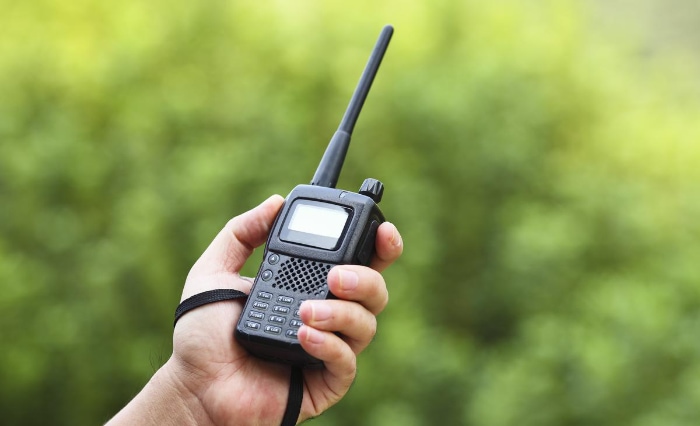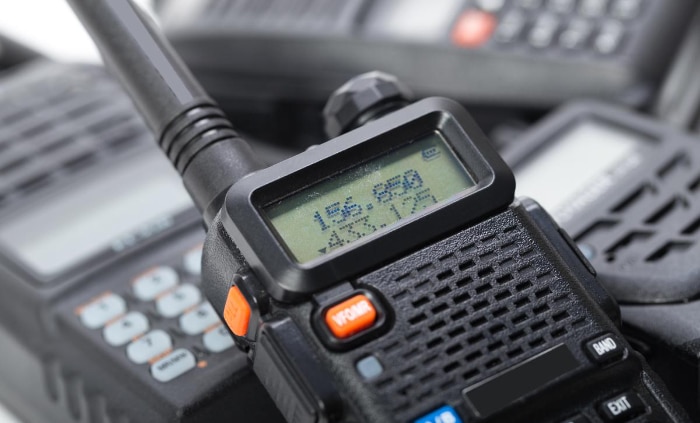How Far Can Walkie-Talkies Reach? Factors and Limitations

Walkie-talkies have long captured the imagination of professionals and enthusiasts alike. Whether it's a group of hikers coordinating their trail route or emergency responders communicating during a crisis, these handheld radios offer a vital link.
But have you ever wondered just how far these devices can actually reach? The range of a walkie-talkie is not merely a question of technology; it's a complex interplay of multiple factors—from the type of radio frequency to geographical and atmospheric conditions.
Basic Understanding of Walkie-Talkies
Walkie-talkies are handheld transceivers that operate on radio frequencies to facilitate two-way communication. While they appear straightforward, their function relies on a range of technological and environmental variables.
Types of Walkie-Talkies
Walkie-talkies come in various types, each catering to specific needs and use-cases. The most commonly used types are Family Radio Service (FRS) and General Mobile Radio Service (GMRS).
FRS radios are generally low-power units with shorter ranges, suitable for personal or recreational activities. GMRS radios, on the other hand, offer more power and subsequently a longer range but usually require an FCC license to operate.
There are also Ultra High Frequency (UHF) and Very High Frequency (VHF) radios, commonly used in professional settings, each with its own pros and cons concerning range and signal penetration.
Basic Mechanism of Operation
The core functionality of a walkie-talkie relies on sending and receiving radio waves. When you speak into the device, your voice is converted into electrical signals, modulated onto a radio wave, and then transmitted through the antenna.
The receiving walkie-talkie captures this signal via its antenna, demodulates the radio wave back into electrical signals, and converts it back to sound through a speaker.
Key Factors Affecting Range
While the walkie-talkie's basic operation might seem simple, the range can be influenced by several crucial factors. These include the frequency band, the efficiency of the antenna, and the power output of the device.
Understanding these elements is crucial for effectively using a walkie-talkie within its range limitations.
Radio Frequency Bands
Walkie-talkies can operate on different frequency bands, each with distinct characteristics affecting the range. Lower frequency bands, such as VHF, are more apt for long-distance communication but may lack the penetration needed in urban or forested environments.
Higher frequency bands like UHF have better penetration through obstacles but may fall short when it comes to maximum range.
Licensing and Regulations
One can't overlook the legal aspects surrounding walkie-talkies. Specific frequencies and types of radios require licensing for legal operation.
For instance, using a GMRS walkie-talkie without a Federal Communications Commission (FCC) license could lead to penalties. Always be aware of the laws and regulations in your jurisdiction to ensure you are using the device legally and responsibly.
Radio Waves and Frequency
To grasp the range limitations and capabilities of walkie-talkies, a fundamental knowledge of radio waves and frequency is indispensable. These are the invisible forces that make two-way, real-time communication possible.
What Are Radio Waves?
Radio waves are a type of electromagnetic radiation, traveling through the air at the speed of light. They serve as the medium through which walkie-talkies send and receive voice or data signals.
When you press the “talk” button on your device, it generates a radio wave that carries the information to another unit tuned to the same frequency.
The Role of Frequency
Frequency refers to the number of cycles a radio wave completes in one second, measured in hertz (Hz). Walkie-talkies usually operate within specific frequency bands, each with its own characteristics and regulations.
Frequency is a critical factor in determining a device's range; lower frequencies often provide more extended range but may suffer when it comes to penetrating obstacles.
Frequency Bands in Walkie-Talkies
Walkie-talkies often operate in VHF (Very High Frequency) and UHF (Ultra High Frequency) bands. VHF typically ranges from 30 MHz to 300 MHz, while UHF spans 300 MHz to 3 GHz.
VHF is well-suited for open landscapes and water, whereas UHF is more efficient in environments with physical obstructions like buildings or dense foliage.
Importance of Licensing
Operating on certain frequencies may require an FCC (Federal Communications Commission) license. For example, GMRS radios usually need a license, as they operate on frequencies that are shared with other services.
Failure to comply with these legal requirements can result in fines and other penalties.
Modulation Techniques
Walkie-talkies use various modulation techniques to place an information signal onto the carrier radio wave. The most common are amplitude modulation (AM) and frequency modulation (FM).
FM is generally more reliable and is the standard for most modern walkie-talkies. The type of modulation also plays a role in the quality and range of the communication.
Interference and Frequency Sharing
Because multiple devices can operate on similar frequencies, there's a possibility of interference. Many modern walkie-talkies come with sub-audible tones or digital codes to filter out other transmissions on the same channel.
This not only helps in maintaining a clean signal but also slightly extends the practical range of the device by reducing interference.
Factors Affecting Walkie-Talkie Range

While the basic mechanism and frequency considerations play a foundational role in determining a walkie-talkie's range, there are also various external factors that influence it. From the terrain to atmospheric conditions, numerous elements can either extend or reduce the distance over which your walkie-talkie can effectively communicate.
Terrain
The geography of the area in which you're using your walkie-talkie has a significant impact on its range. Open fields generally allow for the maximum range specified by the manufacturer.
However, mountains, valleys, and dense forests can dramatically reduce that distance by obstructing the direct path of the radio waves.
Obstructions
In urban settings, buildings, vehicles, and other man-made structures can interfere with walkie-talkie signals. These obstructions can either block or reflect radio waves, leading to reduced range and sometimes causing a phenomenon known as “multi-path distortion,” where signals arrive at the receiver from multiple paths.
Atmospheric Conditions
Weather elements such as rain, fog, and humidity can also affect the performance of walkie-talkies. Moisture in the air can absorb radio waves, leading to a decreased range.
Severe weather conditions can sometimes cause temporary disturbances in radio communications.
Antenna Efficiency
The type and efficiency of the antenna on your walkie-talkie can significantly influence the range. Higher-quality antennas can focus the signal more efficiently, effectively increasing the range of the device.
Some walkie-talkies offer the option to replace the in-built antenna with a more potent one, although this can sometimes require technical expertise.
Power Output
The strength of the radio signal is directly proportional to the power output of the walkie-talkie, measured in watts. Higher wattage will usually result in an increased range, but it also demands more from the device's battery.
It's essential to balance the need for range with battery life, especially in situations where recharging may not be possible for extended periods.
Line of Sight
Radio waves generally travel in straight lines. Therefore, achieving a clear line of sight between two communicating walkie-talkies can often yield the best range results.
This is particularly true for VHF radios, which are more dependent on line of sight compared to their UHF counterparts.
Co-channel Interference
Sometimes your channel may pick up interference from other radios operating on the same frequency. Advanced walkie-talkies offer features like CTCSS (Continuous Tone-Coded Squelch System) or DCS (Digital-Coded Squelch) to minimize such co-channel interference, thereby improving the effective communication range.
Real-World Examples and Scenarios
Having discussed the theoretical aspects affecting walkie-talkie range, applying this knowledge to real-world situations provides valuable practical insights. A range of scenarios can either amplify or limit the effectiveness of walkie-talkie communication.
Hiking in Mountainous Areas
Walkie-talkies are often a go-to communication tool for hikers. However, the mountainous terrain can pose significant challenges.
Radio signals may find it hard to negotiate steep slopes and densely wooded areas, resulting in reduced range. In such instances, higher-powered units with quality antennas can offer better results.
Emergency Response Operations
First responders like firefighters, paramedics, and police officers rely on walkie-talkies for quick, efficient communication. Here, the importance of range can't be overstated.
Conditions can vary widely, from open fields to obstructed urban environments. Knowing the range limitations can help responders better coordinate their activities and ensure safety.
Boating and Marine Activities
Water bodies like lakes and open seas offer relatively fewer obstructions, allowing for a longer range. However, VHF radios are generally preferred over UHF for marine applications because of their better performance over open areas.
It's crucial to understand that while the absence of obstacles can enhance range, factors like antenna height and atmospheric conditions still come into play.
Large Events and Festivals
During large-scale events such as music festivals or sports events, walkie-talkies are indispensable for organizing and security staff. However, large crowds and multiple electronic devices can lead to interference, affecting the range.
In such instances, selecting a less congested frequency and utilizing advanced filtering features can prove beneficial.
Construction Sites
The construction industry often uses walkie-talkies to coordinate between different teams spread out across large areas. Here, the buildings themselves can act as obstructions, reducing the signal range.
Moreover, the presence of machinery and heavy equipment can also cause interference. Using UHF radios with high power output can be an effective countermeasure.
Aviation and Airports
In an airport setting, the enormous open space may suggest that long-range communication is easily achievable. However, the presence of large metal aircraft and complex structures can distort radio signals.
Aviation walkie-talkies are specially designed to offer a good range and clear signal, often utilizing higher power output and specialized antennas.
Retail and Warehouse Management
In smaller environments like retail stores and warehouses, the range might not be a significant concern, but obstacles like shelves filled with goods can impede signals. Here, low-power UHF radios are generally sufficient, and advanced features to minimize interference become more valuable.
Conclusion
Walkie-talkies serve as invaluable communication tools across diverse settings, from hiking expeditions to emergency response and commercial operations. While manufacturers often provide an estimated range, it's crucial to realize that this figure is subject to an array of influencing factors.
Understanding the role of radio waves and frequencies lays the foundation for grasping how walkie-talkies work, while acknowledging various external factors like terrain, obstructions, and atmospheric conditions helps one manage expectations regarding range. Real-world scenarios provide further insight into how these variables interact, making it clear that both the choice of device and its settings can profoundly affect performance.
A nuanced understanding of these elements enables more effective and reliable communication, regardless of the environment you find yourself in.

